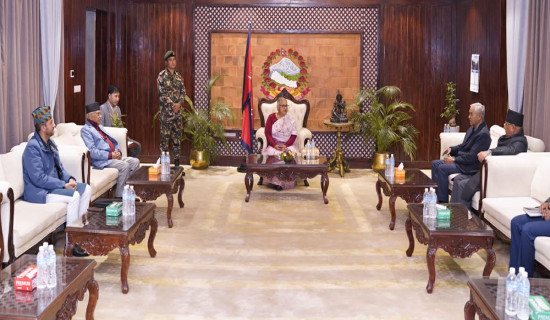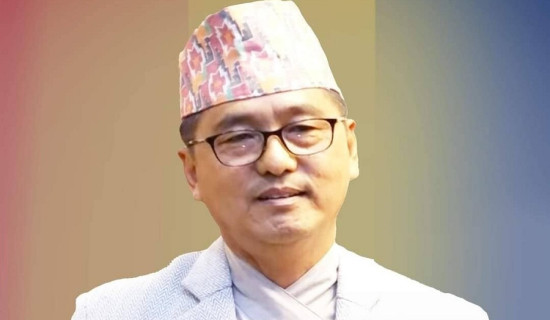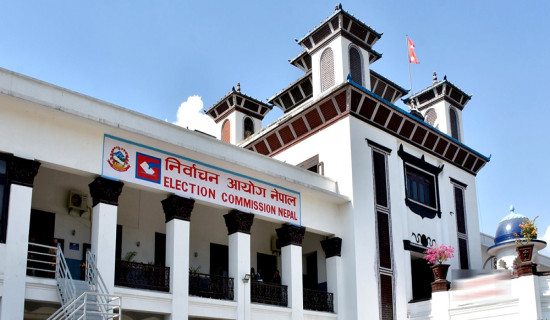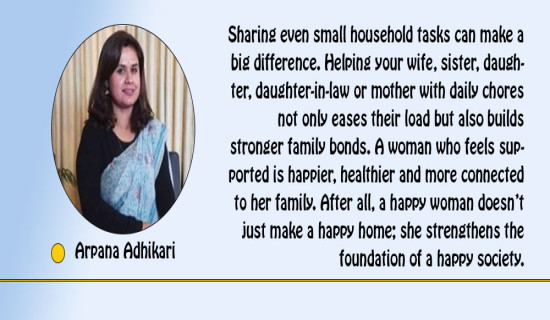- Saturday, 27 December 2025
Unstoppable female workforce
Women overcome barriers to gain wider space in Nepali bureaucracy
Kathmandu, Sept. 7: Women are making significant strides in Nepal’s bureaucracy. In the latest results of the Public Service Commission’s (PSC) examination for judicial officers, women made up over 80 per cent of candidates selected through open competition, a milestone that underscores the growing role of women in governance.
Of the 44 candidates selected in the open category, 38 were women, with only six being men. The top six positions were also secured by women, with the highest-ranking man appearing in the seventh place.
Beyond open competition, women also performed strongly in reserved quotas -13 under the women’s category, three each from indigenous and Madhesi groups and one each from the Dalit and disability categories. Altogether, 81 individuals have been selected from all categories in the judicial service, with 59 (72 per cent) female officers.
Steady rise since reservation policy
This surge in women workforce reflects a broader shift that began with the 2007 amendment to Nepal’s Civil Service Act. The landmark policy introduced 45 per cent reservation in government for women and marginalised groups, allocating 33 per cent to women, 27 per cent to indigenous nationalities, 22 per cent to Madhesi, nine to Dalit, five per cent to persons with disabilities and four per cent to candidates from backward region.
The result has been transformative. In 2008, the first year after the policy was enforced, women made up just nine per cent of Nepal’s bureaucracy. By 2016, this rose to 20 per cent, and by 2018 it reached 24 per cent.
The figures of fiscal year 2023/24 put women’s share at nearly 28.23 per cent and the latest data put women’s representation at nearly 29.5 per cent of total 86,422 civil servants, an all-time high. The data provided by the Department of National Personnel Records (Civil) shows that by September 6, total 25,516 women are in civil service.
Yet this progress still falls short of anticipated balance. Women make up 51 per cent of Nepal’s population, leaving their presence in government far below parity.
Uneven distribution across sectors
Women’s representation is uneven across government services. Data shows that women account for more than 40 per cent of the workforce in health and miscellaneous services, but less than 20 per cent in most other fields.
As per the data of mid-March, 2025, women representation in the parliamentary service was low at a mere 0.62 per cent. Other technical and specialized areas have a similar wide gap. Women’s representation is 15.86 per cent in engineering, 11.45 per cent in judiciary and a mere 2.93 per cent in agriculture.
The figure is lower again in the audit service at 1.19 per cent, the foreign service at 0.71 per cent and economic planning and statistics at 0.70 per cent.
This clustering highlights both preference and structural barriers, indicating that while women are drawn to certain sectors, systemic gaps prevent their participation across the bureaucracy.
The glass ceiling in bureaucracy
Despite an encouraging rise in entry- and mid-level participation, women remain largely absent from senior decision-making roles in Nepal’s civil service. In 1991, women held just three per cent of government secretary positions, and by 2016 their representation dropped to zero. In contrast, their share in non-gazetted groups grew modestly from eight per cent in the 1990s to 14 per cent in 2016.
Recent government data reflects a similar pattern. Of 85,520 civil servants in 2022/23, 24,094 or 28.17 per cent were women. By mid-March 2025, this rose slightly to 29.2 per cent, marking a consistent increase from just 12 per cent in 2008 over 17 years.
However, women remain underrepresented in leadership positions. Currently, there are 442 women under-secretaries, 59 joint secretaries, and only eight women who have reached the rank of secretary across ministries and commissions. The civil service as a whole comprises about 600 joint secretaries, 3,500 under-secretaries, and 10,300 section officers.
The judiciary shows a similar disparity. Of the 240 district court judges, only nine are women. In the high courts, there are 20 women out of 160 judges across seven courts, and the Supreme Court has just one woman judge out of 20 sitting judges.
Women’s representation in administrative leadership is also limited. According to the Ministry of Home Affairs, only 7.79 per cent of Chief District Officer (CDO) posts are held by women. Currently, just six districts have female CDOs, including Ilam, Sankhuwasabha, Kaski, and Solukhumbu. Previously, eight women served as CDOs in the country.
Nepal has achieved some historic milestones in women’s leadership in recent years. In July 2024, the country appointed its first woman Chief Secretary, Lila Devi Gadtaula, a breakthrough in bureaucracy, though her tenure lasted only 35 days due to the mandatory retirement age under the Civil Service Act. Similarly, Sushila Karki became Nepal’s first woman Chief Justice on July 11, 2016, leading the judiciary for nearly a year.
More recently, in April 2025, Durapada Sapkota became the first woman Director General of the Department of Consular Services under the Ministry of Foreign Affairs. In the same month, Neelam Dhungana was appointed acting governor of Nepal Rastra Bank, serving for over a month before becoming Deputy Governor.
These examples highlight a persistent glass ceiling. While women are increasingly competitive in examinations and well-represented in entry- and mid-level roles, their path to executive leadership and decision-making positions remains largely blocked.
Factors behind rise of women in bureaucracy
Experts say affirmative action and inclusion policies have played a crucial role in boosting women’s participation, showing that gender-friendly reforms can reshape public institutions.
Kashi Raj Dahal, a constitution and administration expert, attributes this rise to several factors -- reservation quotas, educational attainment, systematic support, constitutional provisions and affirmative action policies -- have created pathways for women to entre and succeed in civil service and societal attitudes are evolving, with increased emphasis on educating and empowering girls.
Former Chief Secretary and Chairperson of the Commission for the Investigation of Enforced Disappeared Persons (CIEDP), Gadtaula and Director General Durapada Sapkota echoed this view, highlighting that women increasingly see government service as a secure and viable career.
“Reservation quotas have encouraged those who previously lacked confidence to apply. Since they are preparing for the PSC exam, they also test themselves in the open competition, contributing to the increase in their numbers. This also reflects growing interest and confidence among female candidates,” Sapkota noted.
However, male candidates still dominate the pass rates, largely due to structural barrier of the society that continues to hinder women’s progress, said she added.
“Since the implementation of inclusion, women have begun entering government services and feel that these opportunities are for them. The more women join, the greater will be their participation at decision-making levels,” said Radhika Aryal, first female Communication Secretary.
A success story with challenge ahead
The experts agree that while more women are entering bureaucracy, sustained support and inclusive policies are essential to expand their presence at decision-making levels.
Structural barriers and gender biases within the system continue to limit women’s mobility to higher ranks. While political participation has seen gains, women’s representation in executive posts of the civil service remains negligible - leaving them absent from the country’s highest decision-making and policy-shaping, Dahal added.
Sapkota added that many women, both in bureaucracy and beyond, do not compete for higher positions because, burdened by their responsibilities and unaware of their own potential, they remain content with their current roles.
Issues women face in bureaucracy
When Chief Secretary Leela Devi Gadtaula joined the civil service as a legal officer in 1996, there were only two women in her group, and women made up just about seven per cent of civil servants. “Public service was seen as a male domain, creating the misconception that women were not suited to it,” she recalled.
Gadtaula recalled that early in her career, women’s questions often sparked gossips, their mistakes were harshly judged and men frequently received credit for women’s work, as important information and opportunities were shared mostly among men. “The situation has gradually improved,” she added. “With more women in offices, the work environment is now more gender-friendly and women have better access to information and opportunities.”
Communication Secretary Radhika Aryal, who joined civil service in Magh 2004 before reservation quotas were introduced, credited strong family support for her success.
Reflecting on her 21-year career, she said she has not faced significant challenges in her work, as she was always hardworking and remained updated. “Working as Communication Secretary comes with greater responsibility and challenges. Coordinating across different ministries and government bodies often slows decision-making on account of bureaucratic structures. Still, I am happy with my profession,” she said, noting that women often face double challenges in the workplace.
Director General Sapkota recalled that when she entered civil service in 2006, few women appeared for the examination, before reservation quotas were introduced in 2007. She credited strong family support for her success, a privilege not available to many women.
After four years in education sector, she entered the male-dominated Foreign Affairs sector through open competition. As chief of Consular Service, she observed that women often have to prove themselves in leadership roles due to trust issues linked to balancing work and family responsibilities.
The way ahead
Highlighting the authorities and political parties’ role in creating equitable environment, Dahal said, “Sustained support, policy reforms, gender-friendly budgets, women’s economic empowerment and discrimination-free society and workplace are essential to achieve gender parity in the bureaucracy.”
Similarly, Secretary Aryal stressed that confidence and competence are key for women in bureaucracy, noting, “Positions are defined by responsibility, not gender. Women must stay skilled, coordinated and confident in exercising their rights to deliver public service.”
She added that civil service offers ample opportunities if women overcome the mindset of being ‘weak’.
Gadtaula also advised new civil servants to be tolerant, competitive, and committed to accessible service delivery, uphold good governance, and maintain integrity by avoiding irregularities.


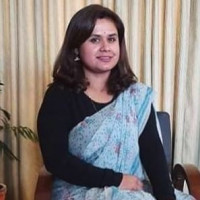

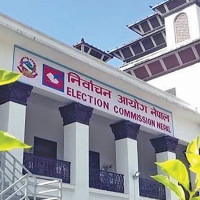
-square-thumb.jpg)
